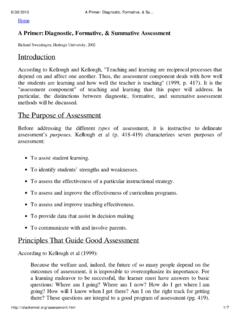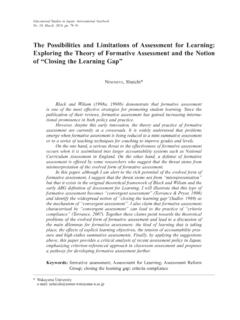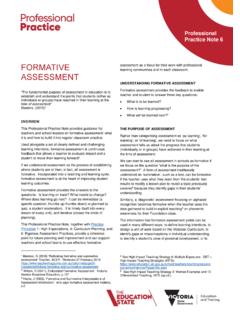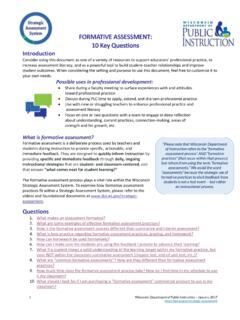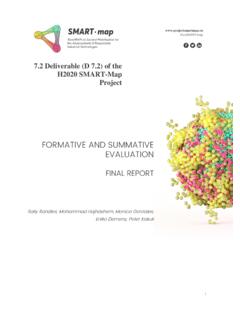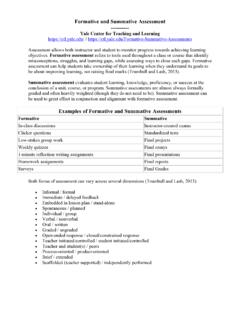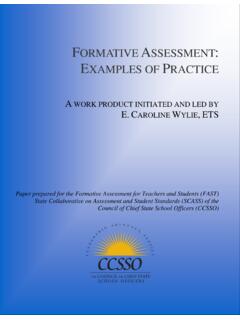Transcription of Formative and Summative Assessments in the Classroom
1 Successful middle schools engage students in all aspects of their learning. There are many strategies for accomplishing this. One such strategy is student-led conferences. As a Classroom teacher or administrator, how do you ensure that the information shared in a student-led conference provides a balanced picture of the student s strengths and weaknesses? The answer to this is to balance both Summative and Formative Classroom assessment practices and information gathering about student is a huge topic that encompasses everything from statewide accountability tests to district benchmark or interim tests to everyday Classroom tests. In order to grapple with what seems to be an overuse of testing, educators should frame their views of testing as assessment and that assessment is information.
2 The more information we have about students, the clearer the picture we have about achievement or where gaps may Formative and Summative Assessments The terms Formative and Summative do not have to be difficult, yet the definitions have become confusing in the past few years. This is especially true for Formative assessment . In a balanced assessment system, both Summative and Formative Assessments are an integral part of information gathering. Depend too much on one or the other and the reality of student achievement in your Classroom becomes Assessments are given periodically to determine at a particular point in time what students know and do not know. Many associate Summative Assessments only with standardized tests such as state Assessments , but they are also used at and are an important part of district and Classroom programs.
3 Summative assessment at the district and Classroom level is an accountability measure that is generally used as part of the grading process. The list is long, but here are some examples of Summative Assessments : State Assessments District benchmark or interim Assessments End-of-unit or chapter tests End-of-term or semester exams Scores that are used for accountability of schools (AYP) and students (report card grades).The key is to think of Summative assessment as a means to gauge, at a particular point in time, student learning relative to content standards. Although the information gleaned from this type of assessment is important, it can only help in evaluating certain aspects of the learning process.
4 Because they are spread out and occur after instruction every few weeks, months, or once a year, Summative Assessments are tools to help evaluate the effectiveness of programs, school improvement goals, alignment of curriculum, or student placement in specific programs. Summative Assessments happen too far down the learning path to provide information at the Classroom level and to make instructional adjustments and interventions during the learning process. It takes Formative assessment to accomplish assessment is part of the instructional process. When incorporated into Classroom practice, it provides the information needed to adjust teaching and learning while they are happening.
5 In this sense, Formative assessment informs both teachers and students about student understanding at a point when timely adjustments can be made. These adjustments help to ensure students achieve targeted standards-based learning goals within a set time frame. Although Formative assessment strategies appear in a variety of formats, there are some distinct ways to distinguish them from Summative Assessments . One distinction is to think of Formative assessment as practice. We do not hold students accountable in grade book fashion for skills and concepts they Formative and Summative Assessments in the ClassroomCatherine Garrison and Michael Ehringhaus, Ph. and Summative Assessments in the Classroom 1have just been introduced to or are learning.
6 We must allow for practice. Formative assessment helps teachers determine next steps during the learning process as the instruction approaches the Summative assessment of student learning. A good analogy for this is the road test that is required to receive a driver s license. What if, before getting your driver s license, you received a grade every time you sat behind the wheel to practice driving? What if your final grade for the driving test was the average of all of the grades you received while practicing? Because of the initial low grades you received during the process of learning to drive, your final grade would not accurately reflect your ability to drive a car. In the beginning of learning to drive, how confident or motivated to learn would you feel?
7 Would any of the grades you received provide you with guidance on what you needed to do next to improve your driving skills? Your final driving test, or Summative assessment , would be the accountability measure that establishes whether or not you have the driving skills necessary for a driver s license not a reflection of all the driving practice that leads to it. The same holds true for Classroom instruction, learning, and distinction that underpins Formative assessment is student involvement. If students are not involved in the assessment process, Formative assessment is not practiced or implemented to its full effectiveness. Students need to be involved both as assessors of their own learning and as resources to other students.
8 There are numerous strategies teachers can implement to engage students. In fact, research shows that the involvement in and ownership of their work increases students motivation to learn. This does not mean the absence of teacher involvement. To the contrary, teachers are critical in identifying learning goals, setting clear criteria for success, and designing assessment tasks that provide evidence of student of the key components of engaging students in the assessment of their own learning is providing them with descriptive feedback as they learn. In fact, research shows descriptive feedback to be the most significant instructional strategy to move students forward in their learning.
9 Descriptive feedback provides students with an understanding of what they are doing well, links to Classroom learning, and gives specific input on how to reach the next step in the learning progression. In other words, descriptive feedback is not a grade, a sticker, or good job! A significant body of research indicates that such limited feedback does not lead to improved student are many Classroom instructional strategies that are part of the repertoire of good teaching. When teachers use sound instructional practice for the purpose of gathering information on student learning, they are applying this information in a Formative way. In this sense, Formative assessment is pedagogy and clearly cannot be separated from instruction.
10 It is what good teachers do. The distinction lies in what teachers actually do with the information they gather. How is it being used to inform instruction? How is it being shared with and engaging students? It s not teachers just collecting information/data on student learning; it s what they do with the information they of the instructional strategies that can be used formatively include the following:Criteria and goal setting with students engages them in instruction and the learning process by creating clear expectations. In order to be successful, students need to understand and know the learning target/goal and the criteria for reaching it. Establishing and defining quality work together, asking students to participate in establishing norm behaviors for Classroom culture, and determining what should be included in criteria for success are all examples of this strategy.
